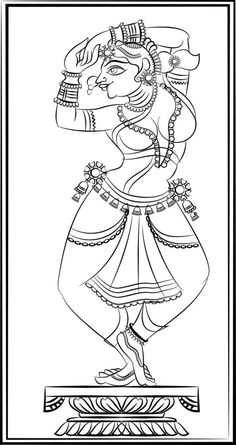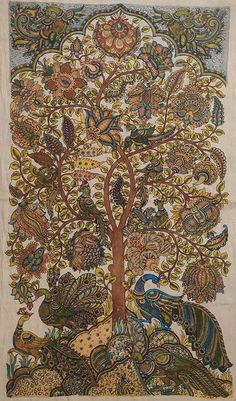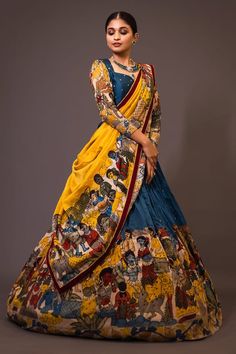Kalamkari Design 02
Kalamkari art is a traditional Indian textile art form that combines intricate hand-painting and block-printing techniques. Originating from the Indian states of Andhra Pradesh and Telangana, this craft is renowned for its elaborate designs, vibrant colors, and rich cultural narratives. Kalamkari literally means “pen work,” referring to the use of a pen-like instrument to draw intricate patterns on fabric. This overview explores the history, techniques, themes, and contemporary relevance of Kalamkari art.
Historical Background
Origins of Kalamkari

Kalamkari has ancient roots, with references found in texts dating back to the Mahabharata and Ramayana. The art form flourished during the Mughal era in India, when artists began to use fine brushes and natural dyes to create detailed images on fabric. Traditionally, Kalamkari was used for temple hangings, clothing, and decorative pieces, reflecting religious and cultural stories.
Cultural Significance
Kalamkari is deeply intertwined with Indian culture and spirituality. The art often depicts mythological figures, deities, and scenes from epics, serving both aesthetic and devotional purposes. It played a crucial role in temple rituals, where beautifully adorned textiles were used for worship and decoration.
Techniques of Kalamkari
Kalamkari employs two primary techniques: hand-painting and block-printing.
Hand-Painting
In the hand-painting technique, artists use a tamarind stick, which is sharpened to a point and dipped in natural dyes. The artist meticulously draws intricate designs, often taking several days to complete a single piece. This technique allows for fine details and intricate storytelling through imagery.
Block-Printing
Block-printing involves carving designs onto wooden blocks, which are then dipped in natural dyes and pressed onto fabric. This method allows for the repetition of patterns, making it more efficient for larger production. Each block is carefully aligned to ensure consistent patterns.
Dyeing Process
Natural dyes derived from plants, minerals, and insects are used in Kalamkari art. Some common sources include:
- Indigo: For deep blue hues.
- Turmeric: For vibrant yellows.
- Pomegranate: For rich reds and browns.
- Alizarin: For shades of red.
The dyeing process is labor-intensive, often involving multiple steps of washing, drying, and fixing the colors to ensure their longevity.
Themes and Motifs
Mythological Narratives
Kalamkari art is famous for its portrayal of scenes from Hindu mythology. Common themes include:
- Epics: Illustrations from the Mahabharata and Ramayana, depicting battles, divine interventions, and moral lessons.
- Deities: Images of gods and goddesses, often surrounded by intricate floral patterns and symbolic motifs.
Nature and Folklore

In addition to mythological themes, Kalamkari often incorporates elements from nature, such as animals, birds, and plants. These motifs symbolize fertility, prosperity, and the interconnectedness of life. Folklore and local legends also find expression in this art form, showcasing regional stories and cultural heritage.
Geometric Patterns
Geometric designs are another significant aspect of Kalamkari. These patterns, often used as borders or background elements, enhance the overall composition and provide a sense of rhythm and balance.
Contemporary Relevance
Revival and Popularity
In recent years, there has been a resurgence of interest in traditional art forms, including Kalamkari. Artists and designers are reinterpreting this ancient craft for modern fashion and home décor, blending traditional techniques with contemporary aesthetics.
Sustainable Fashion
With the growing awareness of environmental issues, Kalamkari’s use of natural dyes and eco-friendly processes has gained popularity in the sustainable fashion movement. Consumers are increasingly drawn to handmade textiles that reflect ethical and sustainable practices.
Workshops and Education
Various organizations and institutions are conducting workshops and training programs to revive and teach Kalamkari techniques. These initiatives not only preserve traditional skills but also empower artisans and promote entrepreneurship within local communities.
Global Influence
Kalamkari art has garnered international attention, with designers and artists around the world incorporating its motifs and techniques into their work. Exhibitions showcasing Kalamkari pieces are becoming more common, further bridging the gap between traditional Indian art and contemporary global art movements.
Challenges Faced by Artisans
Despite its revival, Kalamkari artisans face several challenges:
Economic Viability

Many artisans struggle to earn a sustainable income due to the labor-intensive nature of the craft. The market for handmade textiles can be competitive, and mass-produced alternatives often overshadow traditional products.
Preservation of Techniques
As modern techniques and synthetic dyes become more prevalent, there is a risk that traditional methods may be lost. It is essential to document and teach these techniques to ensure their continuation.
Access to Resources
Artisans often face difficulties in accessing quality raw materials, such as natural dyes and fabric. Improving supply chains and providing resources can significantly impact their livelihoods.
Conclusion
Kalamkari art is a vibrant and dynamic expression of India’s cultural heritage, weaving together mythology, nature, and tradition. Its intricate designs and storytelling capabilities make it a unique textile art form that resonates with people across generations. As we embrace sustainable practices and seek to connect with our roots, Kalamkari continues to find relevance in contemporary society. By supporting this art form, we contribute to the preservation of traditional craftsmanship while celebrating the beauty and richness of Indian culture.
